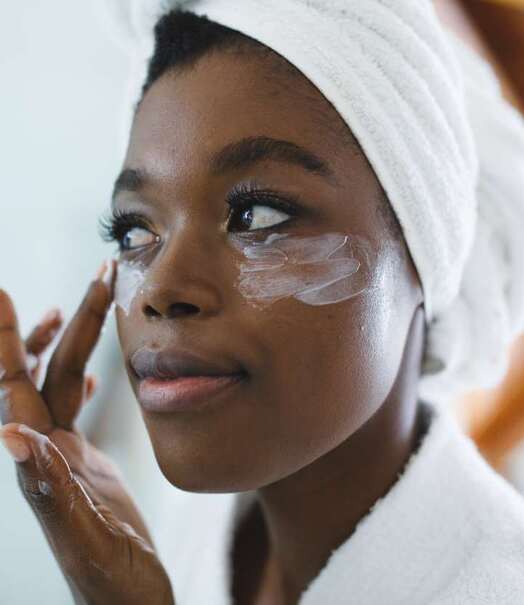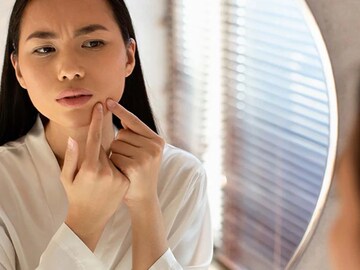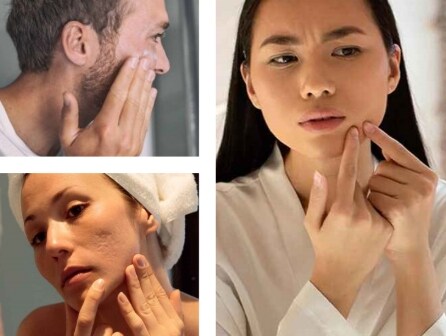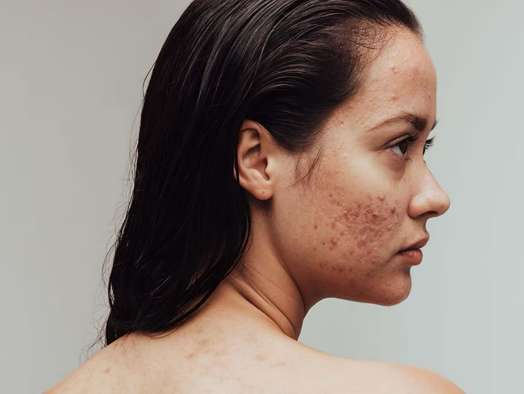Online Acne Treatments & Prescriptions | Walgreens
Online Acne Treatments
Get acne treatments prescribed online, if approved. It’s easy with Walgreens Virtual Healthcare.
Available in select states*

Prescription Acne Treatments Just a Few Clicks Away
How to get acne treatment through Walgreens Virtual Healthcare
During your Walgreens Virtual skincare visit, you will start by completing an online inquiry form to answer questions about your medical history and symptoms. Photos of the front and each side of your face are required for the consultation. Then, a doctor or nurse practitioner will connect with you via secure online chat. If appropriate, they will prescribe a medication for acne that can be sent to your local Walgreens or pharmacy of your choice.
How do prescription acne treatments work?1-11
Acne treatments work by clearing existing acne, minimizing acne scars and preventing future breakouts. These treatments address clogged pores, excess oil production, bacteria overgrowth and inflammation. Some acne treatments are topical (applied directly to the skin) while others are taken orally.
Acne medications take time to produce results. It may take several months to start noticing fewer acne breakouts and clearer skin. While your skin is adjusting to the new medication, you might experience redness, dryness, irritated skin or worsening acne. Using acne medications as prescribed should help minimize these side effects, but always consult your provider with any concerns.
Different types of acne medications work in different ways to prevent and reduce acne. Some of the medications that may be prescribed include:
- Retinoids clear pores and treat existing pimples. They can also help lighten dark spots that may have developed after acne clears. An example of a prescription retinoid used for acne is tretinoin (Altreno®, Atralin®, and Retin-A®). See retinoids safety information.
- Benzoyl peroxide reduces acne-causing bacteria on your skin. It may be combined with other medications for additional benefits. See benzoyl peroxide safety information.
- Topical antibiotics are applied to your skin to treat acne. These medications help reduce acne-causing bacteria as well as inflammation that causes acne. Typically, when using a topical antibiotic, you will also be instructed to use an acne medication or face wash that contains benzoyl peroxide. This combination helps lower the risk of developing antibiotic resistance which occurs when the medication used to kill acne-causing bacteria becomes ineffective. Topical antibiotics are often combined with another acne medication, like benzoyl peroxide or a retinoid, in one combination product so you receive the correct dose of each medication. Some topical antibiotics offered through Walgreens Virtual Healthcare include clindamycin (Cleocin T®) and erythromycin (Erygel®). See topical antibiotics safety information.
- Azelaic acid (Azelex®) is applied directly to the skin. This medication clears clogged pores and helps keep them stay clear. It also fights acne-causing bacteria and reduces inflammation due to acne. In addition, azelaic acid helps reduce dark spots that can occur when acne clears. See azelaic acid (Azelex®) safety information.
- Oral medications such as spironolactone (Aldactone®)† or doxycycline (Monodox®, brand name discontinued) may be prescribed if you have hormonal or moderate to severe acne. These medications work internally to help clear and prevent acne. See spironolactone (Aldactone®) safety information.
Often, these products are be combined to create a skincare regimen specifically designed for the symptoms and goals of therapy of each patient.
†Spironolactone tablets (25mg, 50mg, & 100mg), Rx only, has not been approved by the FDA as safe and effective to treat acne, however studies have shown that it may treat acne. By providing this content, Walgreens in no way supports or endorses the use of this product for such condition. Only a licensed clinician may prescribe this drug for this condition if in their clinical judgment use of the product is medically appropriate.Will insurance cover my acne treatment prescription?
Insurance can help pay for many medications, including those used to treat acne. Please speak with your pharmacist or insurance company about any questions you have regarding your prescription drug coverage. The cost of medication is not included in the cost of your Walgreens Virtual Healthcare visit.
Looking to pay for your medication out-of-pocket? Find lower prescription prices at Walgreens with our free search tool, Walgreens Rx Savings Finder.
Which acne treatment is right for me?
Acne treatments are available in many different forms, concentrations and combinations. Different treatments are prescribed depending on various factors such as the type of acne you may have, the severity of the condition, your symptoms and medical history. During your Walgreens Virtual Healthcare consultation, your provider will evaluate your medical and health history as well as your current symptoms. They will then determine if a treatment for acne is right for you, and if so, which one. Your Walgreens provider will discuss the prescribed medication and can answer questions you may have.
What prescriptions does Walgreens offer for acne treatment?3,6-9,12-15
Acne treatment is available in various forms and combinations based on different causes and symptoms of acne. Your Walgreens Virtual Healthcare provider will discuss the options and determine which type of acne treatment is right for you.
Walgreens Virtual Healthcare providers can prescribe topical and oral medications for acne. Sometimes, multiple medications and dosage forms are needed to reach the goals of treatment. Some examples of topical medications that may be prescribed include:
- Retinoids such as adapalene (Differin®), tazarotene (Tazorac®) and tretinoin (Altreno®)
- Antibiotics such as clindamycin (Cleocin T®) and erythromycin (Erygel®)
- Azelaic acid (Azelex®)
- Benzoyl peroxide
- Salicylic acid
- Combination medications such as adapalene/benzoyl peroxide (Epiduo®)
- Oral medications such as spironolactone (Aldactone®)† or doxycycline (Monodox®, brand name discontinued)
Stay on track with Rx alerts & expert care
Frequently Asked Questions
- When should I see a doctor for acne?16
Many people with acne, whether mild or severe, can benefit from seeing a doctor. A consultation with a provider may help if you have tried to clear your acne but it persists or comes back. If you feel your acne is impacting how you feel about yourself or how you interact with others, you may benefit from discussing your skin concerns with a doctor. Sometimes, as acne clears, you can develop scars or dark spots. A doctor can help determine if there’s a product or regimen that may help reduce the appearance of those scars and dark spots. There are many treatments and regimens that can improve acne. A trained medical professional can help determine the best treatment and skincare routine for you.
- Do I need to talk to a dermatologist for acne treatment online?
At Walgreens Virtual Healthcare, we have physicians and nurse practitioners who have training in many areas, including dermatology. These clinicians can evaluate your specific acne symptoms and history and discuss your goals of therapy.
We recommend making an in-office appointment with a dermatologist if any of the following are true:
- You have severe acne scarring
- You have acne on multiple parts of your body
- You have cystic acne
- You are pregnant or breastfeeding
- You’re interested in the oral medication isotretinoin
- What’s the difference between OTC and prescription acne treatments?17-18
Over-the-counter (OTC) acne treatments are available without a prescription and are recommended for mild to moderate acne. Common active ingredients include benzoyl peroxide, salicylic acid and adapalene. These treatments are milder, may cause fewer side effects, and are often the first step in managing acne.
Prescription acne treatments target moderate to severe cases. They may also be prescribed when OTC options fail or when OTC products are not an appropriate treatment option. Prescription acne treatments include more potent topical retinoids, topical or oral antibiotics and hormonal medications and products that combine multiple acne-fighting ingredients. Prescription treatments require a healthcare provider’s evaluation, and they’re typically stronger than OTC options. While OTC treatments are convenient and accessible, prescription treatments can be tailored for individuals with stubborn or more complex acne.
- Pimples vs. Acne: Is there a difference?19
Yes, there is a difference between pimples and acne.
Acne is a skin condition that occurs when hair follicles under the skin become clogged. Acne includes pimples, papules (inflamed lesions that appear as small pink tender bumps on the skin), nodules (large painful lesions under the skin), cystic acne, acne scars and dark spots on the skin.
Pimples, on the other hand, are just one of the symptoms of acne. They occur when excess oil, dead skin cells and bacteria get trapped inside a pore. When this happens, the bacteria on your skin multiply rapidly in the presence of excess oil. As more bacteria fill the pore, swelling develops and a pimple forms. Pimples are one possible symptom of acne. However, not all acne presents as pimples.
- What causes acne?20
Some of the most common causes of acne include excess or high production of sebum (oil) in the pore, growth of bacteria in the pore and buildup of dead skin cells in the pore.
Factors that may increase your risk of developing acne include:
- Age: Acne can affect individuals of all ages, but it is particularly common among teenagers.
- Hormones: Rising hormone levels during puberty cause more oil production in the glands, increasing the chance of acne. Hormonal changes related to pregnancy can also cause acne.
- Medications: Certain hormone-containing medications, such as corticosteroids, can increase the risk of developing acne.
- Family history: Some studies show an increased chance of developing acne if your parent has the condition.
Some factors that may worsen acne include:
- Poor diet
- Stress
- Pollution
- High humidity
- Vigorously scrubbing your face
- Squeezing or picking at blemishes
- What’s the most common acne treatment prescription?6,9,15
Acne treatment is dependent on many factors such as type of acne, current symptoms, and your health and medication history. Treatment is patient-specific and can change over time. Types of prescription acne medications include retinoids, topical antibiotics, benzoyl peroxide, azelaic acid (Azelex®), oral medications and combination topical products that contain multiple ingredients at prescription strength, such as adapalene and benzoyl peroxide (Epiduo®). Your Walgreens Virtual Healthcare provider can discuss which treatment options are available and which option is the best fit for you.
- Can doctors prescribe acne treatments virtually?
Yes, Walgreens Virtual Healthcare providers can prescribe acne treatments to adults ages 18 to 64 who are not currently pregnant or breastfeeding. Photos of the front and each side of the face are required for the consultation. During this visit, the provider will assess symptoms and medical history. They will then determine if an acne prescription is appropriate.
References
- Ludmann, P. Acne: Diagnosis and treatment. American Academy of Dermatology. June 19, 2024. Accessed May 13, 2025. https://www.aad.org/public/diseases/acne/derm-treat/treat
- Fox L, Csongradi C, Aucamp M, Du Plessis J, Gerber M. Treatment modalities for acne. Molecules. 2016;21(8):1063. doi:10.3390/molecules21081063
- Altreno. Package insert. Dow Pharmaceuticals North America LLC. 2018. https://www.accessdata.fda.gov/drugsatfda_docs/label/2018/209353s000lbl.pdf
- Atralin Gel. Package insert. Valeant Pharmaceuticals North America LLC. 2014. https://www.accessdata.fda.gov/drugsatfda_docs/label/2014/022070s003lbl.pdf
- Retin-A Micro. Package insert. Valeant Pharmaceuticals North America LLC. 2014. https://www.accessdata.fda.gov/drugsatfda_docs/label/2014/020475s021lbl.pdf
- Benzoyl peroxide gel. Package insert. Axia Medical Solutions, LLC. 2019. https://dailymed.nlm.nih.gov/dailymed/drugInfo.cfm?setid=8cb19ffe-f7c0-4500-a56d-234fd8871f87
- Cleocin T. Package insert. Pfizer. 2019. https://www.accessdata.fda.gov/drugsatfda_docs/label/2019/050537s041,050600s018,050615s019lbl.pdf
- Erygel. Package insert. Mylan Pharmaceuticals Inc. 2018. https://www.drugs.com/pro/erygel.html
- Azelex. Package insert. Almirall, LLC. 2019. https://www.accessdata.fda.gov/drugsatfda_docs/label/2024/020428Orig1s027lbl.pdf
- Aldactone. Package insert. Pfizer. 2022. https://www.accessdata.fda.gov/drugsatfda_docs/label/2022/012151s079lbl.pdf
- Doxycycline capsules, USP. Package insert. Chartwell Pharmaceuticals, LLC. 2025. https://www.accessdata.fda.gov/drugsatfda_docs/label/2025/050641s034lbl.pdf
- Differin Gel. Package insert. Galderma Laboratories, L.P. 2023. https://www.accessdata.fda.gov/drugsatfda_docs/label/2023/021753s014s018lbl.pdf
- Tazorac. Package insert. Allergan, Inc. 2011. https://www.accessdata.fda.gov/drugsatfda_docs/label/2011/020600s008lbl.pdf
- Neutrogena Oil-free Acne Wash Sensitive Skin Facial Cleanser Fragrance Free - salicylic acid liquid. Package insert. Kenvue Brands LLC. 2025. https://dailymed.nlm.nih.gov/dailymed/drugInfo.cfm?setid=1a439f48-22f1-73fa-e063-6294a90a3f8e
- Epiduo Gel. Package insert. Galderma Laboratories, L.P. 2013. https://www.accessdata.fda.gov/drugsatfda_docs/label/2013/022320s004lbl.pdf
- Treating acne? Is it time to see a dermatologist? American Academy of Dermatology. Accessed May 15, 2025. https://www.aad.org/public/diseases/acne/diy/when-derm
- Nonprescription acne treatment: Which products work best? Mayo Clinic. May 14, 2024. Accessed May 2, 2025. https://www.mayoclinic.org/diseases-conditions/acne/in-depth/acne-treatments/art-20045814
- Acne – Diagnosis and treatment. Mayo Clinic. July 20, 2024. Accessed May 2, 2025 https://www.mayoclinic.org/diseases-conditions/acne/diagnosis-treatment/drc-20368048
- Acne: Signs and symptoms. American Academy of Dermatology. Accessed May 6, 2025. https://www.aad.org/public/diseases/acne/really-acne/symptoms
- Acne. National Institute of Arthritis and Musculoskeletal and Skin Diseases. July 2023 Accessed May 5, 2025. https://www.niams.nih.gov/health-topics/acne
Disclaimers
*Currently available in the following states: AL, AZ, CA, CO, CT, FL, GA, IL, IN, KY, LA, MA, MD, MI, MN, MO, NC, NJ, NV, NY, OH, OK, PA, SC, TN, TX, VA, WA, WI
Based on national averages. Actual times may vary.
Labcorp and Quest staff are not associates, employees and/or agents of Walgreen Co. or any Walgreens subsidiary or affiliated company. Lab service will be a separate fee, price may vary.
Prescription based on medical evaluation and not guaranteed.
Walgreens-affiliated medical practices are independently owned and operated by licensed physicians who provide services using the Walgreens virtual care program telehealth platform. For more information about the relationship between Walgreens and the medical practices click here.
Walgreens Health Medical Group California P.C. is a California professional medical corporation utilizing the fictitious name “Walgreens Health Medical Group California P.C.” pursuant to Cal. Bus. & Prof. Code § 2415. To view the Fictitious Name Permit click here.
Additional Safety Information
- Retinoids, such as tretinoin (Altreno®, Atralin®, and Retin-A®)1,5
Skin dryness, redness, burning, itching, discoloration, and increased chance of sunburn may occur. Retinoids increase sensitivity to sunlight; protect skin with clothing and broad-spectrum sunscreen (SPF 30+). Use with caution on sunburned skin or eczema.
Minimizing Side Effects: Your provider may instruct you to start with less frequent use, increase as skin adjusts. Wait 30 minutes after washing face before applying. Consult your provider before combining with other skincare products.
Warnings: For external use only. Avoid eyes. Do not use if sensitive/allergic to retinoids. Some forms contain fish proteins—consult provider if you have fish allergy. Not for use in pregnancy or if trying to get pregnant. Consult your provider if breastfeeding. Seek medical help for severe redness, blistering, or swelling. - Benzoyl peroxide1,6-8
Skin redness, burning, itching, peeling, and dryness may occur. These side effects are more likely to occur when combined with other topical acne medications. Benzoyl peroxide may increase sensitivity to sunlight. Avoid unnecessary sun exposure; use sunscreen (SPF 30+).
Warnings: For external use only. Avoid eyes. Do not use if sensitive/allergic to benzoyl peroxide. May bleach hair or dyed fabrics. Seek medical help for severe redness, blistering, or swelling. Consult provider if pregnant, planning pregnancy, or breastfeeding. Do not use on chest if breastfeeding.
Drug Interactions: Using with topical dapsone may temporarily discolor skin/facial hair tan or yellow. - Clindamycin (Cleocin T®)9-10
Skin dryness, redness, burning, itching or peeling may occur. Contact provider if bothersome or persistent.
Warnings: For external use only. Avoid eyes. Do not use if sensitive to clindamycin/lincomycin, or history of regional enteritis, ulcerative colitis or antibiotic-associated colitis. Rare side effects such as watery/bloody diarrhea, colitis, abdominal pain, fever, and nausea have occurred. Seek medical help for serious side effects. Consult provider if pregnant, planning pregnancy, or breastfeeding.
Drug Interactions: Erythromycin topical products may decrease clindamycin effect. - Erythromycin (Erygel®)9,11-12
Skin burning, peeling, dryness, itching, redness, oiliness, eye irritation and tender skin may occur.
Warnings: For external use only. Avoid eyes. Do not use if sensitive to erythromycin. Often used with benzoyl peroxide, topical retinoid or oral antibiotic to prevent antibiotic resistance. A rare side effect of pseudomembranous colitis (watery diarrhea, cramps, fever, mucus in stool) has occurred. Seek medical help if you experience this rare but serious side effect. Consult provider if pregnant, planning pregnancy, or breastfeeding.
Drug Interactions: Erythromycin topical products may decrease clindamycin effect. - Azelaic acid (Azelex®)13
Mild temporary itchiness, burning, stinging or tingling of the skin may occur. Less common: redness, dryness, rash, peeling, irritation, and inflammation of the skin can occur. Temporary irritation may occur on broken/inflamed skin, usually lessens with continued use. Contact provider if irritation continues.
Warnings: For external use only. Avoid eyes. Do not use if sensitive to azelaic acid. Hypopigmentation may occur, monitor if dark complexion. Consult provider if pregnant, planning pregnancy, or breastfeeding. - Spironolactone (Aldactone®)†14
Common side effects include electrolyte imbalances, gynecomastia (usually reversible).
Warnings: Do not use if sensitive/allergic to spironolactone. May cause electrolyte abnormalities. May affect male embryo development if used during pregnancy. Consult provider if pregnant, planning pregnancy, or breastfeeding.
Drug Interactions: Potassium supplements, non-steroidal anti-inflammatory drugs (NSAIDs), angiotensin-converting enzyme (ACE) inhibitors and angiotensin receptor blockers (ARBs) may cause severe hyperkalemia. May increase lithium toxicity.
*Spironolactone tablets (25mg, 50mg, & 100mg), Rx only, has not been approved by the FDA as safe and effective to treat acne, however studies have shown that it may treat acne. By providing this content, Walgreens in no way supports or endorses the use of this product for such condition. Only a licensed clinician may prescribe this drug for this condition if in their clinical judgment use of the product is medically appropriate. - Doxycycline (Monodox®) (brand name discontinued)1,15
Diarrhea, nausea, vomiting, headaches, and vaginal candidiasis may occur. Rare: glossitis, dysphagia, enterocolitis, esophageal irritation/ulceration can occur. Drink full glass of water with each dose to reduce the risk of rare side effects.
Warnings: Do not use if sensitive to doxycycline/tetracyclines. Not for use during pregnancy or in children under 8 (risk of tooth discoloration/enamel hypoplasia). Consult provider if pregnant, planning pregnancy, or breastfeeding. May cause C. diff-associated diarrhea.
Drug/Food Interactions: Absorption may be reduced when taken with calcium-rich foods, bismuth subsalicylate. May reduce efficacy of oral contraceptives. - Adapalene (Differin®)1,16
Common side effects include dry skin, discomfort, itching, peeling, sunburn, warmth/stinging.
Minimizing Side Effects: Your provider may instuct you to start with less frequent use, increasing as skin adjusts. Wait 30 minutes after washing face before applying. Consult provider before combining with other skincare products.
Warnings: For external use only. Avoid eyes. Do not apply to cuts, abrasions, sunburned skin, or eczema. Do not use if sensitive to adapalene. Avoid waxing on treated skin. Weather extremes may be irritating to skin treated with adapalene. Increases sun sensitivity; use sunscreen (SPF 30+). Not for use in pregnancy or if trying to get pregnant. Consult provider if breastfeeding. - Tazarotene (Tazorac®)1,17
Skin peeling, burning/stinging, dry skin, redness, itching, irritation, pain, cracking, swelling, and discoloration may occur.
Warnings: For external use only. Avoid eyes. Do not apply to cuts, abrasions, sunburned skin, or eczema. Do not use if sensitive to tazarotene. Increases sun sensitivity; use sunscreen (SPF 30+). Not for use in pregnancy or if trying to get pregnant. Consult provider if breastfeeding.
Drug Interactions: Do not use with drugs that increase sun sensitivity (thiazides, tetracyclines, fluoroquinolones, phenothiazines, sulfonamides) unless directed by your doctor. - Salicylic acid18-19
Skin irritation, peeling, stinging, and dryness may occur. Get help immediately with any overdose symptoms such as confusion, diarrhea, dizziness, breathing changes, headache, hearing loss/ringing, nausea, stomach pain, or vomiting.
Warnings: For external use only. Avoid eyes. Do not use if sensitive to salicylic acid. Avoid other topical products (abrasive cleansers, alcohol preparations) due to increased irritation unless directed. Prolonged use over large areas may cause toxicity. Do not use more than directed. Avoid other salicylate-containing medications. Consult provider if pregnant, planning pregnancy, or breastfeeding. Do not use on chest if breastfeeding. - Adapalene/benzoyl peroxide (Epiduo®)1,20
Dry skin, redness, scaling, and stinging/burning (most common in first 4 weeks, usually mild/moderate and lessens with continued use) may occur.
Warnings: For external use only. Avoid eyes. Do not apply to cuts, abrasions, eczema, or sunburned skin. Increases sun sensitivity; use sunscreen (SPF 30+). Weather extremes may irritate skin. Consult provider if pregnant, plan to be pregnant, or breastfeeding.
For all medications:
You are encouraged to report negative side effects of prescription drugs to the FDA. Visit www.fda.gov/medwatch or call 1-800-FDA-1088.References
- How to select a Sunscreen. American Academy of Dermatology. Accessed June 12, 2025. https://www.aad.org/public/everyday-care/sun-protection/shade-clothing-sunscreen/how-to-select-sunscreen
- Atreno. Package insert. Dow Pharmaceuticals North America LLC. 2018. https://www.accessdata.fda.gov/drugsatfda_docs/label/2018/209353s000lbl.pdf
- Atralin Gel. Package insert. Valeant Pharmaceuticals North America LLC. 2014. https://www.accessdata.fda.gov/drugsatfda_docs/label/2014/022070s003lbl.pdf
- Retin-A Micro. Package insert. Valeant Pharmaceuticals North America LLC. 2014. https://www.accessdata.fda.gov/drugsatfda_docs/label/2014/020475s021lbl.pdf
- Retinol: Cream, Serum, What It Is, Benefits, How to Use. Cleveland Clinic. Accessed June 13, 2025. https://my.clevelandclinic.org/health/treatments/23293-retinol
- Benzoyl peroxide gel. Package insert. Axia Medical Solutions, LLC. 2019. https://dailymed.nlm.nih.gov/dailymed/drugInfo.cfm?setid=8cb19ffe-f7c0-4500-a56d-234fd8871f87
- Coutinho B. Dapsone (Aczone) 5% gel for the treatment of Acne. American Family Physician. February 15, 2010. Accessed June 13, 2025. https://www.aafp.org/pubs/afp/issues/2010/0215/p451.html#:~:text=Application%20of%20dapsone%20gel%20followed,in%20one%20to%20eight%20weeks.
- Topical acne treatments. MotherToBaby | Fact Sheets [Internet]. Accessed June 13, 2025. https://www.ncbi.nlm.nih.gov/books/NBK582985/
- Clindamycin (topical route). Mayo Clinic. Accessed June 16, 2025. https://www.mayoclinic.org/drugs-supplements/clindamycin-topical-route/description/drg-20063064
- Cleocin T. Package insert. Pfizer. 2019. https://www.accessdata.fda.gov/drugsatfda_docs/label/2019/050537s041,050600s018,050615s019lbl.pdf
- Erygel. Package insert. Mylan Pharmaceuticals Inc. 2018. https://www.drugs.com/pro/erygel.html
- Pseudomembranous colitis. Mayo Clinic. Accessed June 16, 2025. Pseudomembranous colitis. Mayo Clinic. Accessed June 16, 2025.
- Azelex. Package insert. Almirall, LLC. 2019. https://www.accessdata.fda.gov/drugsatfda_docs/label/2024/020428Orig1s027lbl.pdf
- Aldactone. Package insert. Pfizer. 2022. https://www.accessdata.fda.gov/drugsatfda_docs/label/2022/012151s079lbl.pdf
- Doxycycline capsules, USP. Package insert. Chartwell Pharmaceuticals, LLC. 2025. https://www.accessdata.fda.gov/drugsatfda_docs/label/2025/050641s034lbl.pdf
- Differin Gel. Package insert. Galderma Laboratories, L.P. 2023. https://www.accessdata.fda.gov/drugsatfda_docs/label/2023/021753s014s018lbl.pdf
- Tazorac. Package insert. Allergan, Inc. 2011. https://www.accessdata.fda.gov/drugsatfda_docs/label/2011/020600s008lbl.pdf
- Salicylic acid (topical route). Mayo Clinic. Accessed June 16, 2025. https://www.mayoclinic.org/drugs-supplements/salicylic-acid-topical-route/description/drg-20066030
- Neutrogena Oil-free Acne Wash Sensitive Skin Facial Cleanser Fragrance Free - salicylic acid liquid. Package insert. Kenvue Brands LLC. 2025. https://dailymed.nlm.nih.gov/dailymed/drugInfo.cfm?setid=1a439f48-22f1-73fa-e063-6294a90a3f8e
- Epiduo Gel. Package insert. Galderma Laboratories, L.P. 2013. https://www.accessdata.fda.gov/drugsatfda_docs/label/2013/022320s004lbl.pdf
- Retinoids, such as tretinoin (Altreno®, Atralin®, and Retin-A®)1,5








